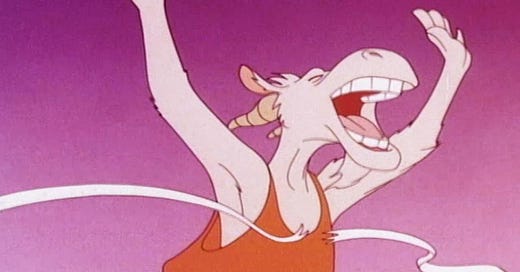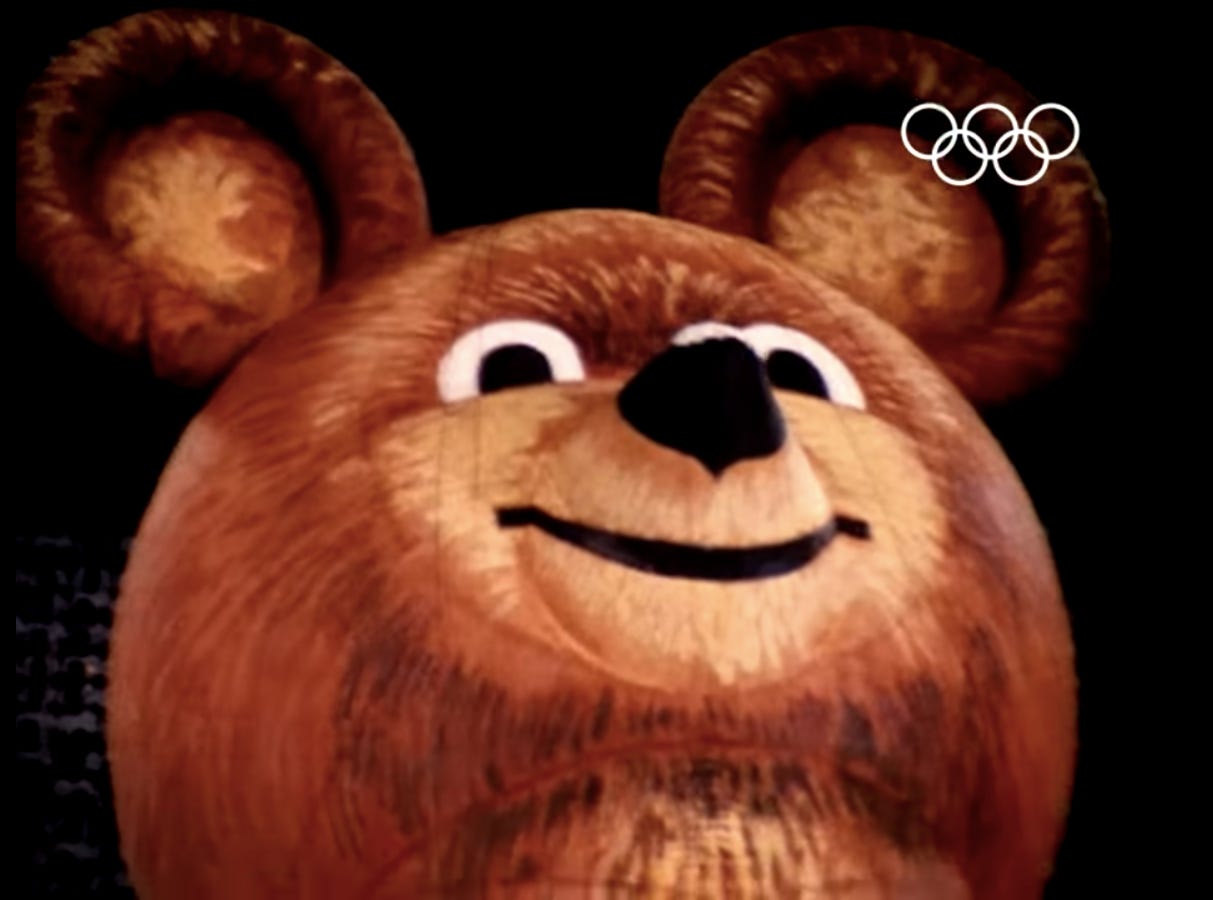Animation At The Olympics, From Misha To Minions
The Olympics are full of extreme movement and quirky mascots. What's not for animators to love?
Let it never be said that animation isn’t a workout. Take the stereotype: an artist sits for hours on end at a desk, hunched over a screen or lightbox, rising only to refill a stained coffee cup once in a while. Yeah, it’s sedentary—but there’s enough tendonitis and carpal tunnel syndrome in the industry to warn us that this is a serious physical undertaking. Animators do stretches and get injured. Animation is a sport.
Could it be an Olympic sport? Well, if I tell you that art competitions were part of the programme until the philistines took over in the 1950s, the idea may not seem so strange. The next host will be Los Angeles, one of the world’s great animation cities, so why not introduce the category? I can picture it: different strands for different techniques; a jury for each; a given theme, a time limit; animators smiling on the podium—or perhaps animating versions of themselves to be projected holographically in their place.
Flippancy aside, animators already have reason to feel included in the Games, medals or no medals. Every four years, as the world meets to compete, animation plays a part in the festivities. This may be truer than ever this year in Paris (another animation hub). Those who watched the rain-soaked opening ceremony on Friday may have spotted references to the Assassin’s Creed games, which are published by France’s Ubisoft, and to pioneering filmmaker Georges Méliès, whose exploration of fantasy and experiments with effects have hugely influenced animation. The ubiquitous Minions were there too, via an original short that revealed them to have “stolen” the Mona Lisa (the franchise is produced at Illumination Studios Paris). In this moment of great cultural self-expression, Paris confirmed that it sees animation as part of its story.
Artists no longer compete at the Olympics, but the promotion of the arts remains a part of the event’s remit. It is in this spirit that the Olympic Foundation for Culture and Heritage commissioned a short anime film to coincide with the last Games, which were held in yet another major animation city: Tokyo (I’m sensing a pattern here). Studio Ponoc was hired and veteran artist Yoshiyuki Momose was put at the helm. The result is Tomorrow’s Leaves, a sumptuous Ghibliesque work in which a band of kids gambol and play whimsical sports, including volleyball with what looks like a glowing cabbage. As a vision for a Japan-themed Games, it is certainly rosier than the dystopian Neo-Tokyo preparing to host the Olympics in Akira (1988).
Tomorrow’s Leaves was conceived separately from the Tokyo mascots, namely Digimon knockoffs Miraitowa and Someity, who had their own animated outings ahead of the Games. Animation has proved a powerful way to promote Olympic mascots, giving them a life beyond their lumbering costumed incarnations.1 Rio 2016 duo Vinicius and Tom, who look like they’ve wandered out of Adventure Time, are among the more appealing characters of recent years; they were created by an animation studio, São Paulo-based Birdo, and featured in a series of shorts broadcast on Cartoon Network Brazil.
Other mascots have performed more historic feats. The five-member Fuwa gang from Beijing 2008 starred in an animated series of 100 episodes (!), while Izzy, the much-derided blue blob from Atlanta 1996, made a groundbreaking CG-animated appearance in the closing ceremony of Barcelona 1992. The latter Olympiad was represented by one of the most beloved mascots to date: Cobi, a lightly Cubist sheepdog created by Javier Mariscal, who also got an animated series (The Cobi Troupe).2
But for enduring popularity, the gold medal surely goes to Misha, the brown bear designed by Victor Chizhikov for Moscow 1980, who appeared in a bunch of shorts by renowned state studio Soyuzmultfilm as well as a series produced in Japan, and has never really gone away. (Compare him with Bely Mishka, one of the three mascots of Sochi 2014, and Misha’s grandson in official Olympic lore; the resemblance is clear, not least to Chizhikov, who cried plagiarism.)
If we step away from official Olympics films and characters, we begin to see how animation ties into the wider culture of the Games. Here in the UK, the BBC has made a tradition of creating high-calibre trailers to accompany its coverage, working with top artists and studios each time. I like how the style varies widely across them, ranging from the naturalistic rainforest animals of the Rio trailer to Gorillaz artist Jamie Hewlett’s designs for the Beijing 2008 one, which he produced with Damon Albarn (watch it below). This year’s trailer, directed by Fx Goby at Nexus Studios, is a touch more classical: it whisks us through a montage of climactic sporting moments, rendered in a slick graphic style that plays attractively with lighting, as Piaf unleashes her Hymne à l’amour on the soundtrack.
Beyond the honouring of specific Olympiads, the format of the Games has sparked the imaginations of animation filmmakers for a century. This makes sense: the Olympics are a parade of extreme and varied movement, which is catnip for animators. Many have seen the potential for parody in the solemn intensity of the competitions. An early example is The Animal Olympics (1928), a silent short by Japan’s Yasuji Murata, who would go on to make several films about sports. Here, beasts big and small face off in a series of antic contests: this is a film in which a pig swallows a balloon, hoping he can float to victory in the hurdles, only to fly off into the sky. A javelin thrown by an elephant later dislodges him from a cloud.3
The same basic idea recurs in Animalympics (1980), an American feature commissioned by NBC ahead of Moscow 1980 (which the US ended up boycotting). The film is structured as a mock-broadcast from the Games, complete with mini-profiles of its cast of oddball zoomorphic athletes (we meet a high-jumping alligator and a family of bobsledding calamari, among many others). There is plenty of charismatic character animation, but the script, heavily reliant on dim cultural stereotypes, can’t sustain the concept across 80 minutes. Notable are a number of turns from eventual stars among the voice cast (Billy Crystal, Harry Shearer) and crew: the animators include Roger Allers, who would go on to direct The Lion King (1994; with Rob Minkoff), and Brad Bird, who would do The Iron Giant (1999) and Ratatouille (2007).
But animation is under no obligation to play the Games for laughs. One of my favourite counter-examples is Olympiad (1971) by Lillian Schwartz, an idiosyncratic study of the human form (watch a clip below). Working with artist and programmer Ken Knowlton, Schwartz married the old with the new, looking back to Eadweard Muybridge’s studies of the human figure while making use of (what was then) cutting-edge computer technology at Bell Laboratories. The result is a hallucinatory two and a half minutes of people running across the screen, vividly coloured, their bodies marked out in mazy lines. One on level, the Olympics have always been a celebration of human anatomy. Animation can be that, too; Olympiad certainly is, as refracted through a wonderfully original artistic vision.
If you have any other Olympics-related animation to share, please do leave a comment below. I’ll make sure to watch it—after the archery and basketball, which I’ll be zapping over to shortly. There’s plenty of this kind of animation out there that I haven’t seen and am keen to discover. The research for my follow-up piece in four years’ time begins here.
Over at Cartoon Research, Fred Patten wrote a three-part overview of Olympic mascots and animation some years ago. It’s worth a read.
Mariscal, for his part, went on to direct the music-themed animated features Chico and Rita (2010; with Fernando Trueba and Tono Errando) and They Shot the Piano Player (2023; with Trueba).
For the All the Anime blog, Helen McCarthy penned this neat little history of how sports and the Olympics have been represented in anime.






I would recommend a collection of shorts made by Hungarian animators for the 1984 Games—currently available to watch on Filmio (https://filmio.hu/sorozat/olympia-84-956). Not exactly what you are hoping for, but they were part of an attempt to integrate animation into the Olympics (https://www.awn.com/mag/issue1.4/articles/deneroffini1.4.html). Not all the participant films were made for the occasion / themed accordingly (e.g., Schwizgebel's Hors-jeu), but it's a quintessential piece of Olympian animation History.
@_@ Today years old when I learned that art was once part of the Olympics... though I was slightly disappointed to learn that it was submission based, not on the spot.